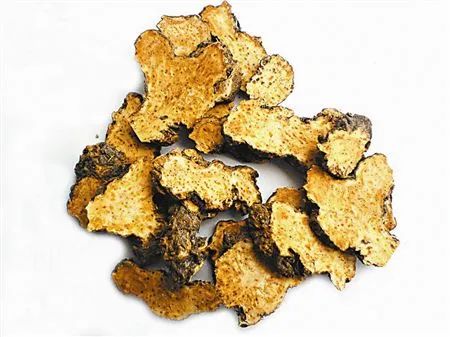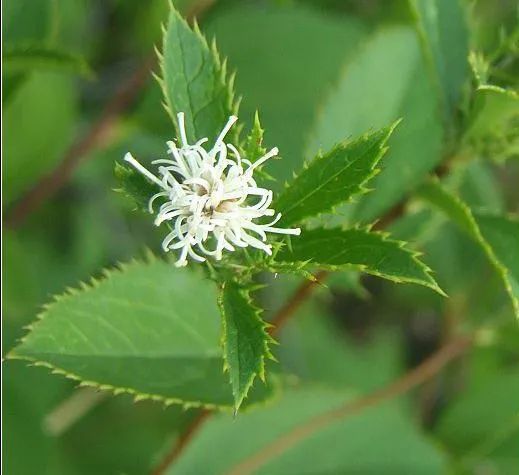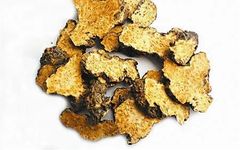Understanding Cāngzhú

【Herb Name】Cāngzhú (Atractylodes Rhizome)
【Properties】Acrid, Bitter, Warm.
【Meridians】Spleen, Stomach, Liver.
【Functions】Dries dampness, strengthens the spleen, dispels wind and cold, brightens the eyes.
【Indications】1. Dampness obstructing the middle jiao, abdominal distension, diarrhea, edema; 2. Wind-damp bi syndrome, beriberi; 3. Wind-cold common cold; 4. Night blindness, blurred vision.

The Story of Cāngzhú

Scholar Xu, a title given to the renowned physician Xu Shuwei of the Song Dynasty, was known for his exceptional medical skills.
It is said that in his youth, Xu was extraordinarily diligent, studying late into the night before going to bed. He had a habit of drinking alcohol before sleep, perhaps believing in the saying, “A sip of wine before bed can extend life to ninety-nine.” After several years, he began to feel a gurgling in his stomach, pain in his side, reduced appetite, and would vomit a bitter and sour gastric fluid every ten to fifteen days. In summer, his left side would not sweat, while his right side would. What kind of strange illness was this? Xu fell into deep thought and sought treatment everywhere. However, despite consulting many famous doctors, he found no relief, which caused him great distress. Thus, he abandoned the belief that “a doctor cannot treat himself” and began to save himself.
He carefully analyzed his condition and concluded that his illness was primarily caused by “dampness obstructing the stomach.” Following his principle of “using precise medication,” he chose Cāngzhú as the main herb, using one pound of Cāngzhú powder, fifteen jujubes, and half a tael of raw sesame oil to make small pills, taking fifty pills daily. He gradually increased the dosage to one hundred to two hundred pills per day. After several months of treatment, his strange illness gradually improved until he was completely cured.
Why did Cāngzhú have such efficacy and a remarkable therapeutic effect on Xu’s strange illness? It turned out that Xu had a fondness for drinking, which harmed his spleen and stomach. A deficiency in the spleen leads to an inability to transform dampness, causing “dampness to obstruct the stomach,” resulting in the gurgling sound in his stomach, lack of sweating on the left side of his body in summer, and vomiting gastric fluid, all symptoms of internal dampness. The spleen belongs to the earth element, which prefers warmth and fragrance. Cāngzhú has a fragrant aroma, is acrid, warm, and bitter, and enters the spleen and stomach meridians. The medicinal properties matched perfectly, as Cāngzhú is aromatic and effectively awakens the spleen and transforms dampness; dampness is a yin energy that can be transformed with warmth.
Xu accurately diagnosed his condition and selected the appropriate herb, achieving remarkable results with just one herb. It is also important to note that Xu’s insistence on long-term medication and gradually increasing the dosage was a thoughtful approach. He understood that dampness is sticky and difficult to eliminate quickly. Only by persisting with long-term medication and gradually increasing the dosage could he enhance the herb’s potency in the body and ultimately conquer the dampness.

Detailed Explanation of Cāngzhú

This herb is the dried rhizome of the perennial herbaceous plant Atractylodes macrocephala or Atractylodes lancea, primarily produced in Jiangsu, Henan, Hebei, Shanxi, and Shaanxi, with the best quality coming from the Maoshan area in Jiangsu, hence the name Atractylodes macrocephala. It is harvested in spring and autumn, cleaned of dirt, dried, and the fibrous roots are removed. It can be used raw or stir-fried with wheat bran.
【Dosage】Decoction, 3-9g.
【Clinical Combinations】
1. Combined with Houpo (Magnolia Bark) and Chenpi (Dried Tangerine Peel), suitable for dampness obstructing the middle jiao, spleen failing to transport, leading to abdominal distension, nausea, reduced appetite, vomiting, diarrhea, and fatigue, with a white greasy tongue coating, as in Pingwei San (Pingwei Powder); 2. Combined with Fuling (Poria), Zexie (Alisma), and Zhuling (Polyporus), suitable for spleen deficiency with damp accumulation, phlegm retention, diarrhea, or edema, as in Weiling Tang (Weiling Decoction); 3. Combined with Yiyiren (Job’s Tears) and Duhuo (Angelica Pubescens), suitable for bi syndrome with excess dampness, as in Yiyiren Tang (Yiyiren Decoction); 4. Combined with Shigao (Gypsum) and Zhimu (Anemarrhena), suitable for damp-heat bi pain, as in Baihu Jia Cāngzhú Tang (Baihu Decoction with Cāngzhú); 5. Combined with Huangbai (Phellodendron) and Yiyiren, suitable for damp-heat descending, beriberi with swelling and pain, weakness, as in Simiao San (Four Marvels Powder); 6. Combined with Longdancao (Gentian) and Huangqin (Scutellaria), suitable for damp-heat leukorrhea, damp sores, eczema; 7. Combined with Qianghuo (Notopterygium) and Baizhi (Angelica Dahurica), suitable for wind-cold exterior syndrome with dampness, as in Shenxiao San (Shenxiao Powder); 8. Used alone or steamed with lamb liver or pig liver, suitable for night blindness and blurred vision.
【Related Formulas】1. Jiuwei Qianghuo Tang 2. Wujisan 3. Yueju Wan 4. Xiaofeng San 5. Pingwei San 6. Danggui Nian Tong Tang 7. Ermiaosan 8. Wandan Tang
【Mnemonic Verse】
Cāngzhú is acrid, bitter, and warm,
It enters the spleen, stomach, and liver meridians,
Dries dampness, strengthens the spleen, dispels wind-damp,
Night blindness, blurred vision, and fluid retention.
【Preparation Methods】
1. Cāngzhú: Take the raw herb, remove impurities, soak in water, wash clean, moisten thoroughly, cut into thick slices, dry, and sift out debris.
2. Stir-fried Cāngzhú: First heat the pan, sprinkle in wheat bran, heat over medium heat until smoking, then add Cāngzhú slices, continuously stir-fry until deep yellow, remove, sift out the bran, and cool. Use 10kg of wheat bran for every 100kg of Cāngzhú slices.
3. Charred Cāngzhú: Place Cāngzhú slices in a hot pan, heat over medium heat until charred brown, spray with a little water, then dry over low heat, remove and cool, and sift out debris.
【Preparation Effects】
1. Cāngzhú: Acrid, bitter, warm. Enters the spleen, stomach, and liver meridians. Functions to dry dampness, strengthen the spleen, dispel wind, scatter cold, and brighten the eyes. Raw Cāngzhú is warm and acrid, with strong damp-drying and wind-dispelling properties. Used for wind-damp bi pain, numbness of the skin, pain in the knees and feet, wind-cold common cold, body aches, damp-heat fever, and joint pain.
2. Stir-fried Cāngzhú: The acrid taste is reduced, the drying property is moderated, the aroma is enhanced, and it strengthens the spleen and stomach function, used for spleen-stomach disharmony, phlegm retention, abdominal fullness, night blindness, and blurred vision.
3. Charred Cāngzhú: The acrid and drying properties are greatly reduced, primarily used to solidify the intestines and stop diarrhea. Used for spleen deficiency diarrhea, chronic dysentery, or women’s leukorrhea with white discharge.
【Differentiation of Medicinal Use】
Cāngzhú, Huoxiang (Agastache), and Peilan (Eupatorium) are all aromatic damp-transforming herbs with the ability to resolve dampness obstructing the middle jiao. However, Cāngzhú is bitter, warm, and drying, capable of drying dampness and strengthening the spleen, suitable not only for damp obstruction in the middle jiao but also for other conditions of excessive dampness; while Huoxiang and Peilan are mildly warm or neutral, primarily used for transforming dampness and awakening the spleen, often used for conditions of dampness obstructing the spleen.
Copyright Statement
This article is organized and published by Xingren Baba. Please indicate the source when reprinting. The content and illustrations are compiled from the “Traditional Chinese Medicine” textbook, “Mnemonic Verses for Traditional Chinese Medicine,” “300 Common Chinese Medicinal Herbs Identification and Application Color Atlas,” and TCM Tong, etc. If there is any infringement, please contact for immediate deletion.


